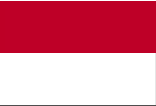|
Indonesia
|

|
Capital: Jakarta
Population: 270,625,568
Brief History of Indonesia:
One of the first major kingdoms to emerge in Indonesia was the Srivajay naval kingdom in the 7th century. The religious influences of Buddhism and Hinduism arrived with the Srivajay kingdom. Next, the Buddhist Sailendra and the Hindo Mataram dynasties arose as the major powers in the land. Many great monuments were left by these dynasties. In the 13th century the Hindo Majapahit kingdom was founded and under its great leader, Gajah Mada, the kingdom spread over much of today's Indonesia.
The first Europeans to arrive were the Portuguese in 1512. They were followed by the Dutch and the British. The Dutch East India Company soon became the dominant power and began to colonize the area taking control for the next several hundred years. In 1942, during World War II, Japan occupied the islands of Indonesia. After Japan lost the war, Indonesia asked for its independence. It took several years of struggle, but in 1949 the Netherlands gave Indonesia its independence. Indonesia has had its problems developing, including repressive military rule up until 1999, widespread poverty, and overpopulation.
Indonesia is the fourth most populous country in the world. Over 140 million people live on the island of Java which is one of the most densely populated areas of the world. It is also home to the world's largest Muslim population.
The Geography of Indonesia
Total Size: 1,919,440 square km
Size Comparison: slightly less than three times the size of Texas
Geographical Coordinates: 5 00 S, 120 00 E
World Region or Continent: Southeast Asia
General Terrain: mostly coastal lowlands; larger islands have interior mountains
Geographical Low Point: Indian Ocean 0 m
Geographical High Point: Puncak Jaya 5,030 m
Climate: tropical; hot, humid; more moderate in highlands
Major cities: JAKARTA (capital) 9.121 million; Surabaya 2.509 million; Bandung 2.412 million; Medan 2.131 million; Semarang 1.296 million (2009)
The People of Indonesia
Type of Government: republic
Languages Spoken: Bahasa Indonesia (official, modified form of Malay), English, Dutch, local dialects, the most widely spoken of which is Javanese
Independence: 17 August 1945 (independence proclaimed); 27 December 1949 (Netherlands recognizes Indonesian independence)
National Holiday: Independence Day, 17 August (1945)
Nationality: Indonesian(s)
Religions: Muslim 88%, Protestant 5%, Roman Catholic 3%, Hindu 2%, Buddhist 1%, other 1% (1998)
National Symbol: garuda (mythical bird)
National Anthem or Song: Indonesia Raya (Great Indonesia)
Economy of Indonesia
Major Industries: petroleum and natural gas, textiles, apparel, footwear, mining, cement, chemical fertilizers, plywood, rubber, food, tourism
Agricultural Products: rice, cassava (tapioca), peanuts, rubber, cocoa, coffee, palm oil, copra; poultry, beef, pork, eggs
Natural Resources: petroleum, tin, natural gas, nickel, timber, bauxite, copper, fertile soils, coal, gold, silver
Major Exports: oil and gas, electrical appliances, plywood, textiles, rubber
Major Imports: machinery and equipment, chemicals, fuels, foodstuffs
Currency: Indonesian rupiah (IDR)
National GDP: $1,125,000,000,000
** Source for population (2012 est.) and GDP (2011 est.) is CIA World Factbook.
Back to Geography Home Page
